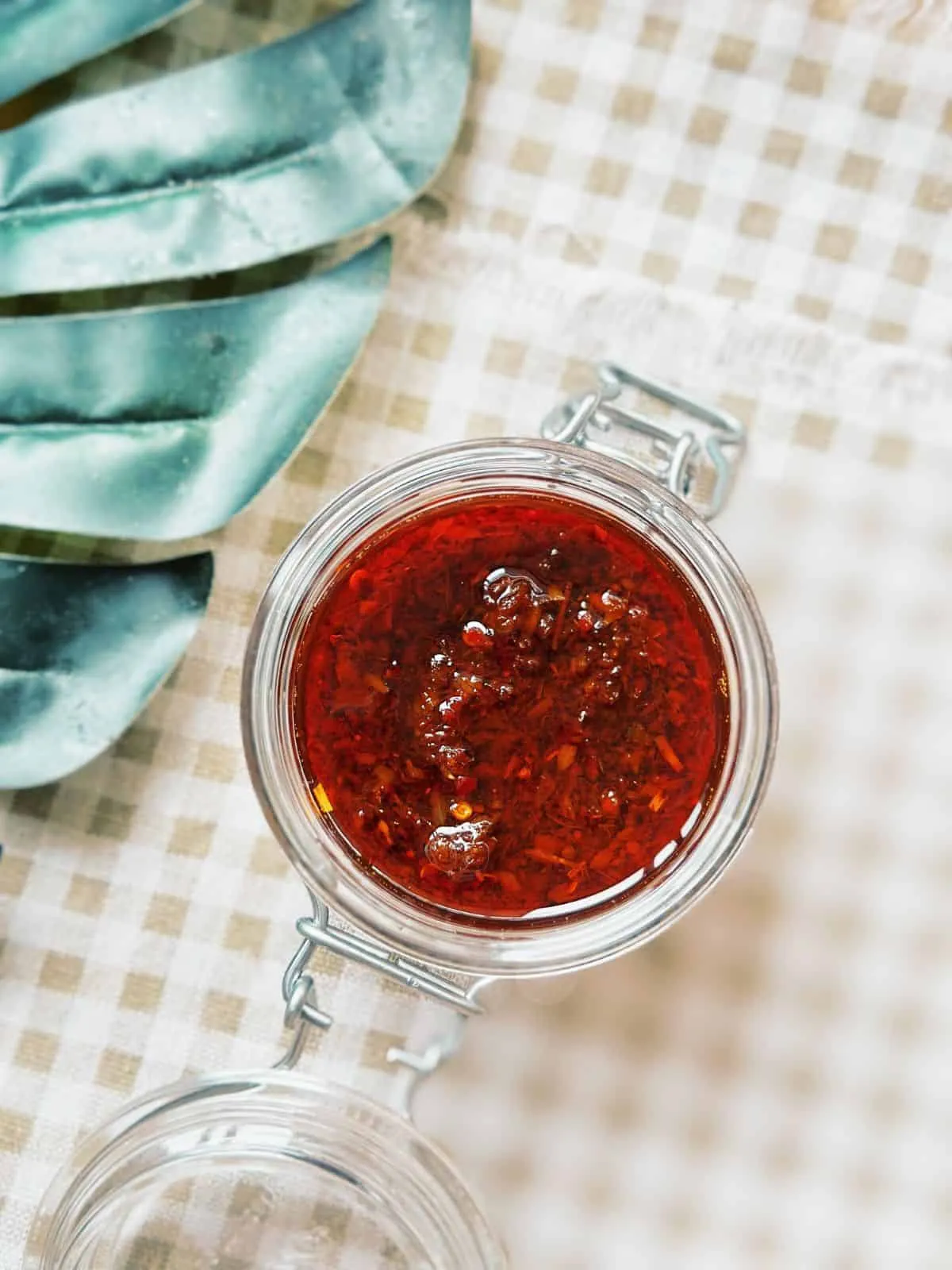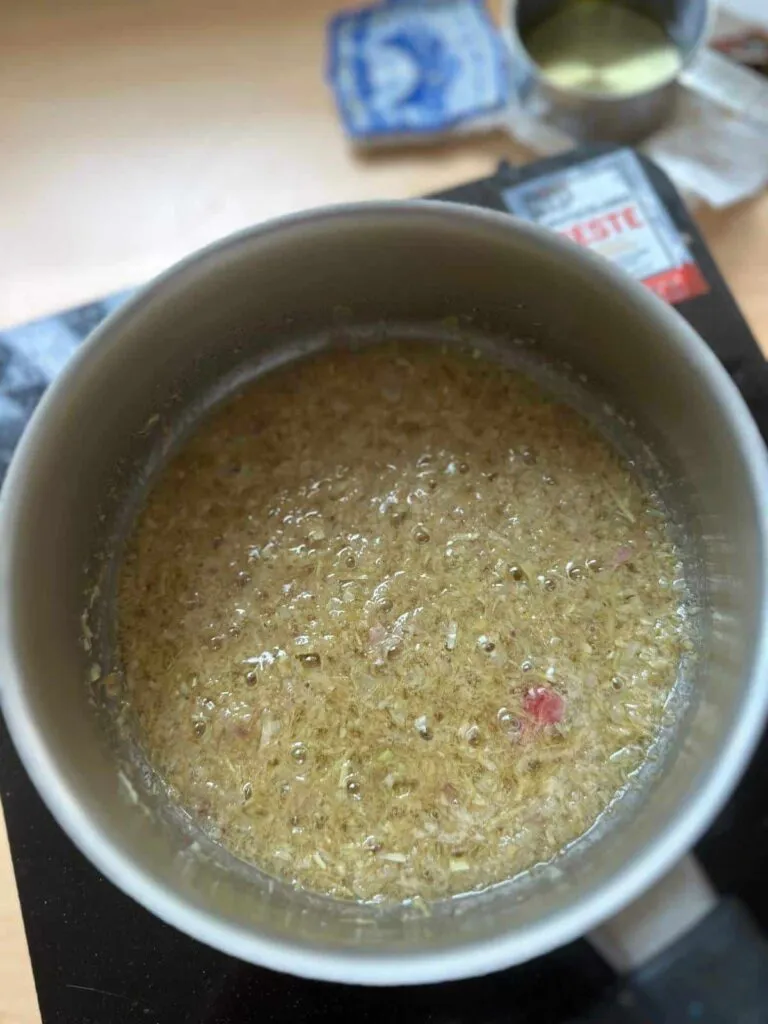Known by various names such as Vietnamese Sate Sauce or Vietnamese Chili Oil, this Vietnamese condiment provides a spicy and flavorful touch to a wide range of Vietnamese dishes, including noodles, noodle soups, dipping sauces, marinades, and particularly grilled or stir-fried creations.
The best part is that making this condiment is a breeze, requiring only 15 minutes of your time. Therefore, this Sate Chili Oil deserves a permanent spot in the pantry of any Asian food lovers.

Table of Contents
🙋♀️ What is Sốt Sa Tế ?

Vietnamese Sate Sauce is a chili-based condiment made by frying chili, lemongrass, and garlic in hot oil. This unique Vietnamese sauce not only adds a spicy kick to your dishes but also enhances their visual appeal with its vibrant red color.
Vietnamese vs. Indonesian / Thai Sate (Satay)
Vietnamese Sate Sauce is distinct from the Thai, Malaysian, and Indonesian versions of Peanut Sate (or Satay), which is typically a peanut-based sauces for skewers.
💎 Vietnamese Sate Sauce vs. Chinese Chili Oil vs. Sambal:
Chili oil and chili sauce are common ingredients in various cuisines, but today I want to talk about my three favorite versions: Vietnamese Sate Chili Oil, Chinese chili oil, and Sambal.
Sốt Sa Tế (Vietnamese lemongrass chili oil):
This sauce stands out with its fresh note of lemongrass, complemented by garlic, shallot, and fish sauce.
Chinese Chili Oil:
Recipes for Chinese chili oil are quite diverse with a combination of spices and aromatic ingredients such as Sichuan peppercorns, star anise, cinnamon, and bay leaves. Making it at home is surprisingly easy, but if I’m feeling a bit lazy (or just want that classic flavor), my go-to is Lao Gan Ma Chili Crisps from the store.
Chinese chili oil is also my favorite ingredient if I want to spice up my Chinese-inspired dishes, like chili oil fried eggs or chili oil noodles.

Sambal:
This well-known chili paste originates from the Javanese people in Malaysia and Indonesia. There are about 200 different versions of Sambal.
The basic recipe involves stir-frying crushed chili (fresh or dried) in oil and enhancing it with ingredients like belacan (shrimp paste), palm sugar, and tamarind juice. Sambal is served with Malaysia’s national dish, Nasi Lemak.
🛒 Ingredients for Sate Chili Oil:
To simplify the preparation process, I opted to dried chili flakes instead of fresh chili. Moreover, to make it suitable for vegans, I have omitted fish sauce from the recipe.

- Crushed chili flakes: I used two types of chili flakes for a combination of spiciness and vibrant color. The Chinese variety provides a spicy flavor, while the Korean one (Gochugaru) adds a rich red hue.
- Lemongrass: This aromatic ingredient plays a dominant role in shaping the flavor profile of the Sate sauce.
- Minced garlic and minced shallots: These essential aromatics are a must-have for achieving the authentic taste of sate sauce.
- Galangal: Adding a small amount of galangal can elevate the flavor of your sauce, although it is optional.
- Cooking oil
- Soy sauce, vegetable bouillon powder and sugar: These ingredients contribute to the savory and slightly sweet notes that balance the spiciness of the sauce.
📝 Instructions
Mince the lemongrass:
- Finely mince the lemongrass and galangal (optional) using a food processor. Using a food processor ensures a finer texture and prevents clumps of lemongrass in your sate sauce (frozen minced lemongrass works well for this recipe).
Mix chili flakes with water:
- Mix the chili pepper flakes with water and the seasonings (sugar, soy sauce, and vegetable bouillon powder). This helps to prevent the chili pepper flakes from burning when added to the hot oil.
Fry the chili and lemongrass in cooking oil:
- In a saucepan, heat ¾ of the cooking oil. To test if the oil is hot enough, dip a kitchen chopstick into the oil, and if bubbles slowly come from the tip, the oil is ready. Add the minced shallots and lower the heat to medium. Cook the shallots for about 30 seconds, then add the minced garlic.
- Stir-fry the shallots and garlic in the oil for around 2 minutes or until they turn slightly golden. Then add the processed lemongrass and galangal. Cook on medium heat for about 3 minutes, stirring occasionally, until the lemongrass has reduced in volume and acquired a bit of color.


- Add the chili flake mixture to the saucepan and cook on medium heat (about 5 minutes). Continuously stir the mixture to prevent it from burning. The lemongrass chili oil is done when the liquid has reduced, the sauce has a glossy jam-like texture, and the aroma of the aromatics is amazing. At this point, you can add the remaining oil and adjust the seasoning according to your preference.
- Transfer the sauce to a bowl or container and allow it to cool completely. Store it in an airtight container in the refrigerator, where it can last for several months.


🌟 Helpful Tips:

Avoid burning the aromatics. When cooking the aromatics such as lemongrass, garlic, and shallots, it is important to avoid using high heat. High heat can cause the aromatics to burn, resulting in a bitter taste. Instead, use medium heat to gently cook the aromatics and allow the oil to infuse with their flavors.
🔥 Variations:
- For non-vegan or non-vegetarian options, you can use fish sauce instead of soy sauce or Mắm ruốc (Vietnamese shrimp paste) in the recipe. This adds a distinct savory flavor that complements the spices and aromatics.
- To enhance the umami profile of the sauce, some Vietnamese recipes include finely chopped dried shrimps, creating Sa Tế Tôm (or Shrimp Sate Sauce). The addition of dried shrimps adds an extra depth of flavor and a hint of seafood essence to the sauce.
🍲 How to use Vietnamese chili oil:
As mentioned earlier, this versatile sauce can be used in various ways. Here are some suggestions for incorporating Vietnamese Sate Sauce into your culinary creations:
- Drizzle Vietnamese chili oil over noodle dishes or noodle soups like Phở, Hủ Tiếu Nam Vang, Mì Khô, Hủ Tiếu Khô.
- Drizzle the chili oil over Vietnamese Hoisin Peanut Sauce. This sauce pairs amazingly well with Vietnamese Spring Rolls like Gỏi Cuốn, Bò Bía, or even a modern twist like my chicken summer rolls.

- Marinate grilled dishes, such as pork, beef, chicken, or tofu, especially those that call for lemongrass. It works particularly well with recipes like:
- Add a spicy kick to stir-fried dishes as well as Vietnamese Rice Paper Pizza (Bánh Tráng Nướng) since it could elevates the flavors of everything.
- Sốt sa tế is also an essential ingredient in some Vietnamese noodle soups, such as:
- Since the recipe is vegan-friendly, you can use this Vietnamese sate sauce in dishes like Bún Chay (Vietnamese rice noodle salad with lemongrass tofu and oyster mushroom) or Bún Bò Huế Chay (Vegan Hue spicy beef noodles).

Other Recommended Recipes for Asian foodies:
If you’ve tried this recipe or any others from my blog, please share your creations with me on Instagram by tagging #savour_thepho or mentioning me in your stories with @savour_thepho. I would be thrilled to see what you’ve made and it would definitely brighten my day! Don’t forget to stay in touch with me on Instagram, Facebook, Pinterest, YouTube 🥰.

Sốt Sa Tế (Vietnamese Fried Chili & Lemongrass Sauce)
Equipment
- 1 Saucepan
- 1 Food Processor
Ingredients
- 4 stalks lemongrass
- 2 tbsp minced garlic (15g)
- 4 tbsp minced shallots (30g)
- 1 tsp galangal (5g) (optional)
- 4 tbsp hot chili pepper flakes
- 3 tbsp Korean pepper flakes (Gochugaru)
- 3 tbsp water
- 2 tbsp soy sauce (to your taste)
- 1 tbsp sugar (to your taste)
- 1 tsp vegetable bouillon powder (to your taste)
- 1 cup vegetable oil (240ml)
Instructions
- Use a food processor to finely chop the lemongrass and galangal (optional). This will give you a smooth texture and prevent large pieces of lemongrass in your sauce. Alternatively, you can use frozen minced lemongrass.
- Mix the chili pepper flakes with water and the seasonings (sugar, soy sauce, and vegetable bouillon powder). Water helps to prevent the chili flakes from burning when you add them to the hot oil.
- Heat ¾ of the cooking oil in a saucepan. To check if the oil is hot enough, dip a kitchen chopstick into the oil. If bubbles slowly come from the tip, it means the oil is ready. Add the minced shallots and reduce the heat to medium. Cook the shallots for about 30 seconds, then add the minced garlic.
- Stir-fry the shallots and garlic in the oil for around 2 minutes or until they turn slightly golden. Next, add the processed lemongrass and galangal (if using). Cook on medium heat for about 3 minutes, stirring occasionally, until the lemongrass reduces in volume and gets a bit of color.
- Add the chili flake mixture into the saucepan and cook it over medium heat for about 5 minutes. Keep stirring to prevent the chili flakes from burning. The lemongrass chili oil is ready when the liquid reduces, the sauce becomes glossy and jam-like, and it has a wonderful aroma. You can add the remaining oil and adjust the seasoning to your taste.
- Transfer the sate sauce to a bowl or container and let it cool completely. Store Sate chili oil in an airtight container in the refrigerator, where it will stay good for several months.









